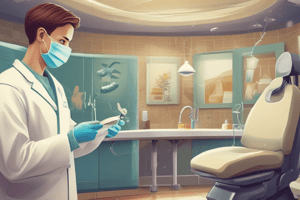Podcast
Questions and Answers
What is the primary source of microorganisms found in dental-unit waterlines (DUWLs)?
What is the primary source of microorganisms found in dental-unit waterlines (DUWLs)?
Which of the following factors does NOT contribute to bacterial contamination in dental-unit waterlines?
Which of the following factors does NOT contribute to bacterial contamination in dental-unit waterlines?
What role does biofilm play in the contamination of DUWLs?
What role does biofilm play in the contamination of DUWLs?
Which organism type cannot multiply within dental-unit waterlines (DUWLs)?
Which organism type cannot multiply within dental-unit waterlines (DUWLs)?
Signup and view all the answers
What is the consequence of ‘suck-back’ in dental-unit waterlines?
What is the consequence of ‘suck-back’ in dental-unit waterlines?
Signup and view all the answers
What conditions in dental unit waterlines contribute to biofilm formation?
What conditions in dental unit waterlines contribute to biofilm formation?
Signup and view all the answers
What is a key reason for the importance of maintaining clean dental unit waterlines?
What is a key reason for the importance of maintaining clean dental unit waterlines?
Signup and view all the answers
Which method is NOT mentioned as a way to minimize biofilm in dental unit waterlines?
Which method is NOT mentioned as a way to minimize biofilm in dental unit waterlines?
Signup and view all the answers
What is a disadvantage of using self-contained water systems in dental practices?
What is a disadvantage of using self-contained water systems in dental practices?
Signup and view all the answers
What characteristic must chemical agents used in DUWL treatment NOT possess?
What characteristic must chemical agents used in DUWL treatment NOT possess?
Signup and view all the answers
Study Notes
Dental Unit Waterlines (DUWLS)
- DUWLS contain more bacteria than faucets.
- Stagnant water in the lines encourages biofilm growth.
- Biofilm is a community of bacterial cells and other microbes.
- Biofilm adheres to surfaces and forms a protective slime layer.
- Biofilm forms where moisture meets suitable solid surfaces.
- Biofilm includes bacteria, fungi, algae, and protozoa.
- Viruses do not multiply in biofilm.
- Exopolysaccharide slime (EPS) protects biofilm cells.
- Water channels within biofilm carry nutrients.
- Planktonic organisms can break off from biofilm and contaminate coolant and irrigating solutions.
- DUWLS provide suitable conditions for biofilm formation.
- Low water pressure, low flow rates, and frequent stagnation promote biofilm.
- Output water often has high bacterial contamination despite sterile source water.
- Dental personnel can inhale contaminated aerosols from contaminated DUWLS.
- Legionellosis (a serious type of pneumonia) is a potential health risk from contaminated water.
- Public water supply is the primary source of microorganisms in DUWLS,
- Saliva can enter DUWLs during treatment: "suck-back."
- Public water often has a low Colony Forming Unit (CFU) count
- But CFU counts increase rapidly in the DUWLs.
- Biofilm development has stages: initial attachment, irreversible attachment, maturation I & II, dispersion.
- Planktonic bacteria adhere to the surface, then form biofilm.
Methods of Reducing Biofilm
- Self-contained water reservoirs.
- Chemical treatment regimens.
- Microfiltration.
- Flushing of waterlines.
Self-Contained Water Reservoirs
- Supply air pressure to the water bottle.
- Force water into DUWLs to handpieces/air-water syringes.
- Dental personnel can choose water type.
- Dentist and staff control water system maintenance.
- Daily reservoir emptying is necessary.
Chemical Agents
- Biofilm regrowth in DUWLS happens within a week.
- DUWLs need regular treatment to eliminate biofilm.
- Chemical products should be effective, compatible with DUWL components, non-toxic to patients/DHCP, and environmentally friendly.
- Introducing chemical agents can be intermittent or continuous.
- Intermittent treatment involves placing a chemical agent (in a reservoir) and flushing the water lines.
- Chemical should remain in contact with tubing for designated time.
- Afterward, the chemical should be thoroughly flushed with water.
- Treatment duration depends on the disinfectant type.
- If the unit is connected to municipal water, turn off the connection before treatment.
- Continuous treatment: mixing the chemical agent with the dental treatment water, or adding agent to a reservoir inside the dental unit for continuous release.
Microfiltration Cartridge
- Disposable inline cartridge reduces bacterial contamination.
- Can be put close to the handpiece, air-water syringe or the bottle.
- Daily replacement is necessary.
- Combining cartridges with water reservoirs improves water quality.
Flushing Waterlines
- Flushing for 2 minutes in the morning and 20-30 seconds after each patient is a norm.
- Longer flushes recommended after weekends.
- Flushing at the beginning of the day should be done without connected handpieces.
Water Quality Monitoring
- Bacterial counts of non-pathogenic bacteria in water should be as low as possible without exceeding 500 CFU/mL.
- Monitor water quality regularly
- Follow manufacturer recommendations for sampling DUWLs.
- Steps followed if no recommendations are given; clean air-water/syringe, instrument hose, patient cup filler, waterline, and spittoon rinse waterlines of the dental unit for 2 minutes before collecting samples.
- Collect 50 mL of water from each outlet and from independent water reservoir bottles.
- Store samples between 2 and 8°C, and return to the microbiology laboratory within 24 hours of collection.
- Label samples with details including the sampled waterline, sender's reference, sampler, date, and time of sampling.
Studying That Suits You
Use AI to generate personalized quizzes and flashcards to suit your learning preferences.
Related Documents
Description
This quiz covers the critical aspects of dental unit waterlines (DUWLS) and the associated risks of biofilm formation. Learn about the conditions that promote bacterial growth, the composition of biofilms, and the potential health implications for dental personnel. Test your knowledge on maintaining safe dental practices.




